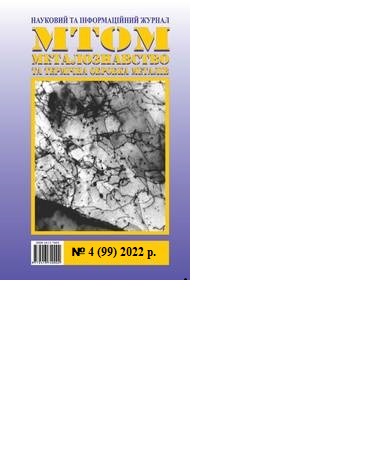APPLICATION OF EXPERT AND FRACTAL ASSESSMENTS IN FORECASTING THE QUALITY OF CONSTRUCTION STEEL
DOI:
https://doi.org/10.30838/J.PMHTM.2413.271222.32.908Keywords:
steel 20, chemical composition, mechanical properties, structure, expert assessment, modelAbstract
Introduction. Different approaches are used to study the structure and properties of structural steels. The properties of steels are determined using traditional methods (physical methods, field tests, X-ray analysis, microscopy, etc.). Structure studies are also carried out using traditional methods based on Euclid's integer geometry. A similar approximation of structural elements by Euclid's figures leads to a decrease in the accuracy of forecast models due to the complex shape of its elements. The reason for this is the fractality (fine dimensionality) of most elements of the material structure. The paper proposes an approach based on a combination of expert and fractal assessments when creating a forecast model for the quality of construction steel. Materials and methods. Construction steel 20 in the mode of factory delivery was studied. The steel had a ferrite-pearlite structure. Mechanical tests and determination of chemical composition were carried out in accordance with the existing regulatory documents (DSTU 7809). The content of pearlite in steel ranged from 10 to 18 %, depending on the amount of carbon. Ferrite occupied the entire other part of the area of the slide examined under the Neophot-2 optical microscope. The results of the experiment. Expert assessment was used to predict mechanical indicators of strength with the aim of reducing material and time costs for conducting field tests with metal samples. The effect of the ferrite-pearlite structure on the mechanical characteristics of strength was investigated by comparing the fractal evaluations of the structure with the indicators of mechanical tests. It has been established that an increase in the fractal dimension of pearlite has a positive effect on the growth of strength indicators of steel 20. A similar effect is, in a certain way, associated with the change in the shape of pearlite grains in the process of changing the amount of carbon in steel within the limits of regulatory documents. Conclusions. For structural steel 20, models for assessing its mechanical characteristics were obtained using the fractal dimensions of structural elements and expert assessments. Coefficients of pairwise correlation of regression equations are recorded in the range of 0.65...0.85. The obtained results can be used to forecast strength indicators of steel, which is especially relevant when assessing its residual resource during operation.

Downloads
Published
Issue
Section
License
Authors that are published in this journal agree to follow the conditions:
Authors reserve the right to the authorship of his work and cede the right to the journal of first publication of this work on conditions of the license under the Creative Commons Attribution License, which allows others to distribute it freely with the obligatory reference to the author of the original work and the first publication of the work in this journal.
